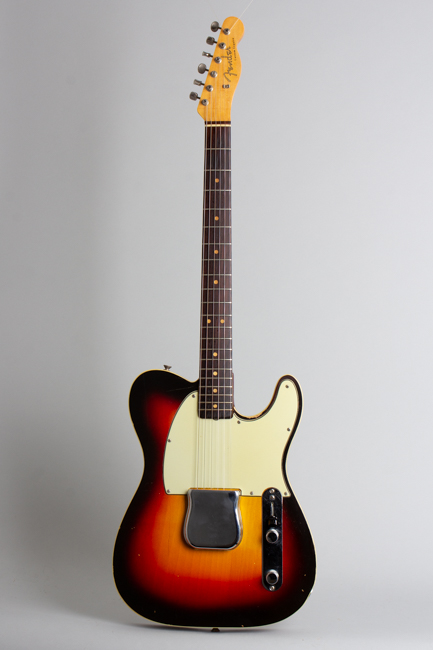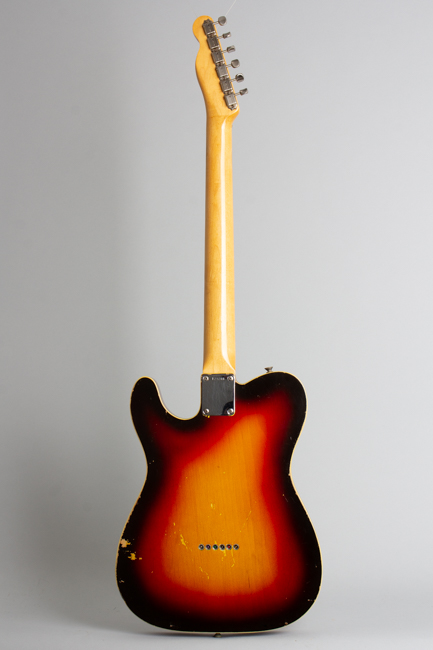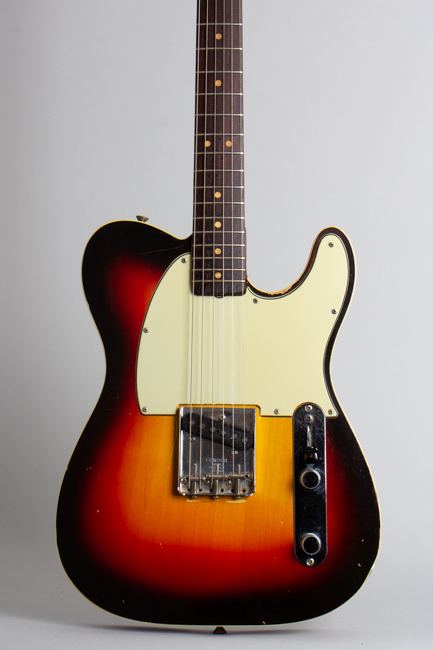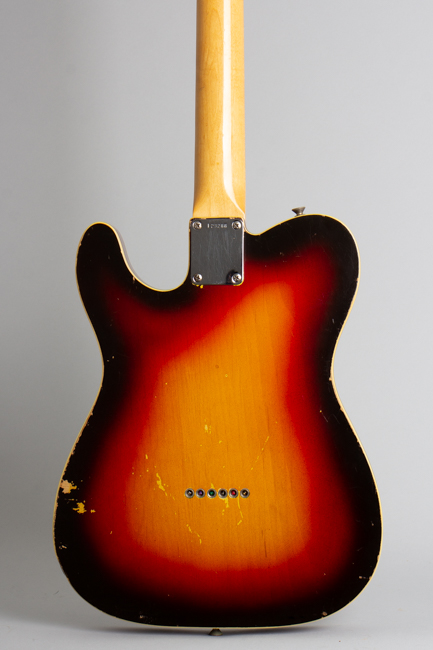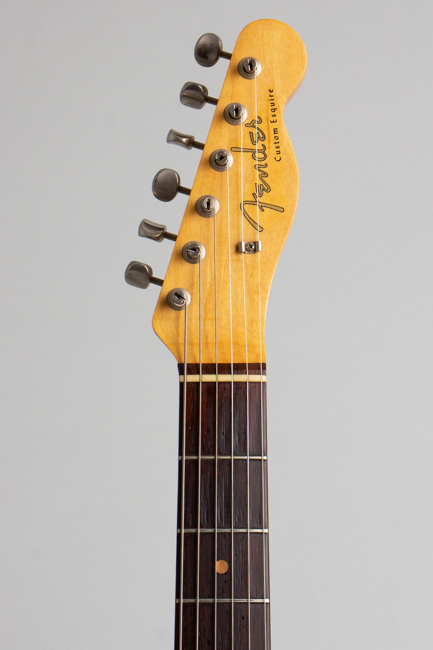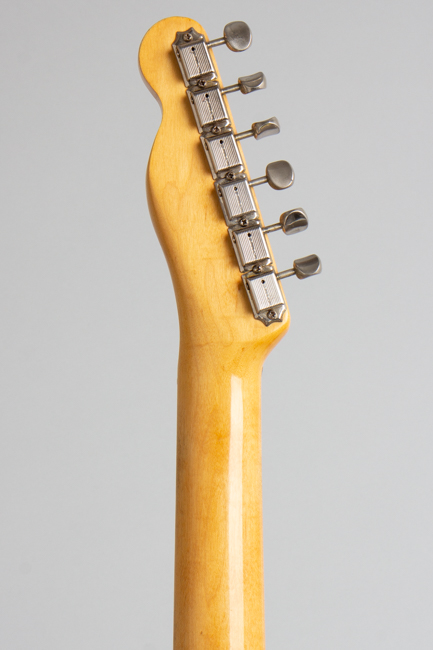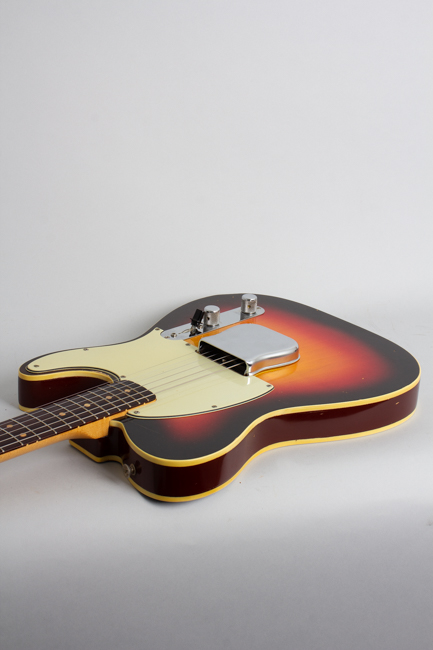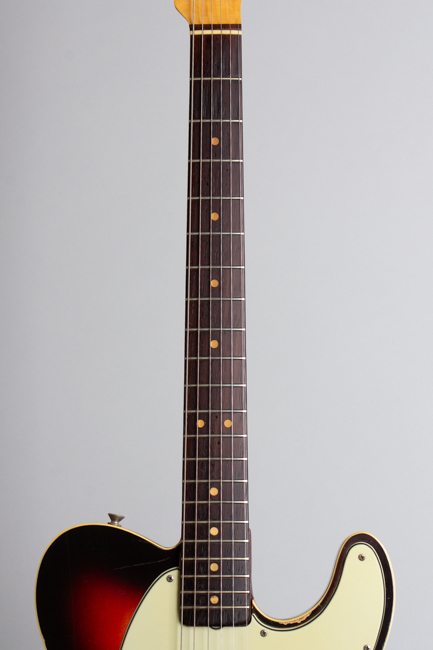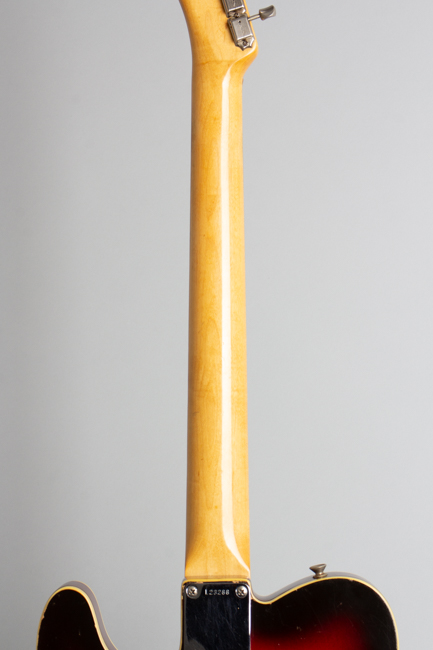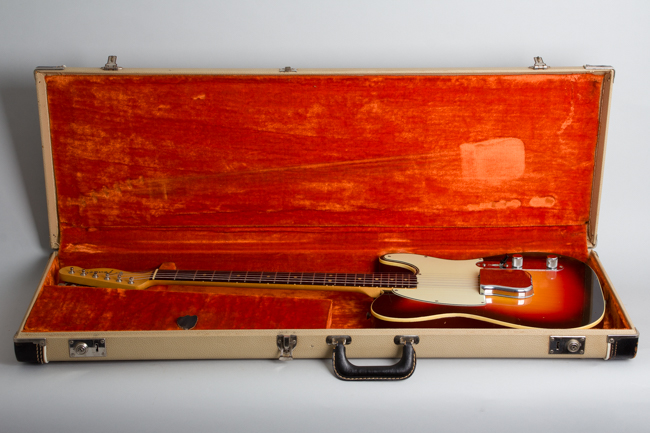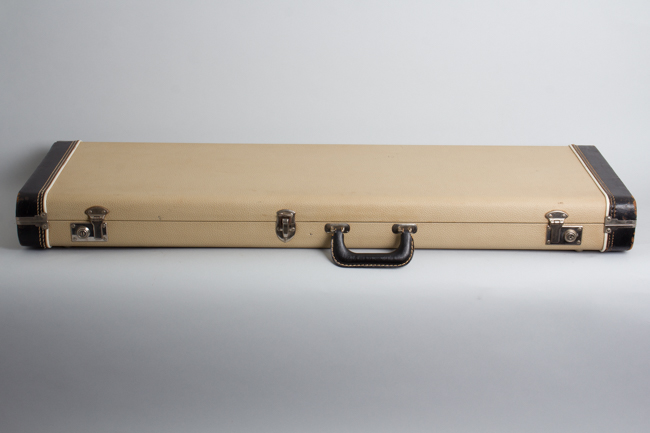Fender Esquire Custom Solid Body Electric Guitar (1963)
This item has been sold.
Item # 11202
Prices subject to change without notice.
Fender Esquire Custom Model Solid Body Electric Guitar (1963), made in Fullerton, California, serial # L23288, sunburst lacquer finish, alder body, maple neck with rosewood fingerboard, original white tolex hard shell case.
This is one of our very favorite (and quite rare) Fender guitars; an original Pre-CBS bound-body Custom Esquire. In 1959 Fender decided to offer flashier versions of the plain-looking Telecaster and Esquire, their original standard guitars. These models had been available for nearly 10 years at that point, and perhaps thought to be lagging behind the sleeker Stratocaster and brand new liquid-sculpture Jazzmaster in eye appeal. "Two Fender Favorites have a startling new look" exclaimed the 1959 brochure.
The slab-sided alder body is bound with white celluloid on the edges and finished in a bold 3-color sunburst. The pickguard was made of the new heavier laminated celluloid Fender had just discovered, ostensibly white but showing a pale-greenish hue in practice. They also introduced the then-new rosewood fingerboard in place of the earlier one-piece maple neck. Telecaster and Esquire Customs were introduced at the 1959 NAMM show and although subsequently available for just about 10 years were never made in large quantities. The Customs were striking-looking, but offered no sonic advantage over the regular models and were somewhat more expensive. This "high-end" Esquire seems to have shown little sales appeal, and by the time this one was assembled in 1963-4 the Custom Esquire was made in minimal numbers, likely only when a dealer ordered one.
This rare single-pickup Custom Esquire has OCT 63 stamped on the neck heel; the pots are date coded to the 50th week of that year so the guitar was likely assembled and sold in early 1964. Apart from the cosmetic upgrades the Custom Esquire is essentially the same as its plain vanilla sister. The single pickup in the treble position is mounted to a metal plate bridge unit also carrying the three adjustable threaded saddles for the strings, fed through the body.
The staggered-pole pickup is controlled by a volume, tone, and 3-way switch with a "top hat" tip offering three tonal options: the #1 bass-heavy rolloff setting, the #2 straight tone control, and #3 "bypass" sending the signal straight to the jack. This last setting is the Esquire's secret bonus, offering some of the finest, snarliest tones ever to emerge from the Fullerton factory. This is fantastic sounding guitar-especially for having just one pickup-bright but not thin, twangy with bite and body.
By the mid-60s, sales of both versions "budget" single-pickup Esquire had fallen off dramatically, outpaced by newer Fullerton models both higher and lower priced, especially the Duo-Sonic and Musicmaster covering the student market. As the 1960s progressed, all Esquires were ordered in ever-shrinking numbers, making them much rarer than any given year's Teles. This 1963-4 example has survived the 58 years since very nicely, a Fender rarity that's a joy to play...even to just hold (and smell)! This gussied up Esquire remains a fantastic example of the original Fender aesthetic, one of the all-time coolest of Leo's children.
Overall length is 38 5/8 in. (98.1 cm.), 12 5/8 in. (32.1 cm.) wide at lower bout, and 1 3/4 in. (4.4 cm.) in depth, measured at side of rim. Scale length is 25 1/2 in. (648 mm.). Width of nut is 1 5/8 in. (41 mm.).
Overall this is a clean and 100% original guitar, showing some play wear but no heavy finish loss. The original vibrant sunburst finish has hardly faded at all, showing plenty of the often-faded red pigment. The finish overall shows small dings, dents, scuffs and scrapes with the only notable loss being some small flaking spots here and there.
All fittings and hardware are correct and original including the complex multi-capacitor Esquire wiring rig. The plating is relatively clean. The guitar appears to have been played mostly with that cover on as the bridge and saddles show minimal wear. The pickguard has less slight shrinkage than most and no pulling or cracks at the screw holes.
The original frets show some very light wear in the lower positions, but not enough to affect play. The clay dot rosewood fingerboard shows hardly any wear at all. This is a wonderful guitar to play, with the classic Esquire "less is more" sonic character that we are always drawn in by. It dwells in the original Fender White Tolex case which is one of the cleanest we have seen in a long time; the "eau du Fendeur" scent when it is opened is very strong and enticing. This is simply a stunning example, about as nice as we ever expect to see in the 21st century ready for the next 60 years and beyond. Excellent - Condition.
This is one of our very favorite (and quite rare) Fender guitars; an original Pre-CBS bound-body Custom Esquire. In 1959 Fender decided to offer flashier versions of the plain-looking Telecaster and Esquire, their original standard guitars. These models had been available for nearly 10 years at that point, and perhaps thought to be lagging behind the sleeker Stratocaster and brand new liquid-sculpture Jazzmaster in eye appeal. "Two Fender Favorites have a startling new look" exclaimed the 1959 brochure.
The slab-sided alder body is bound with white celluloid on the edges and finished in a bold 3-color sunburst. The pickguard was made of the new heavier laminated celluloid Fender had just discovered, ostensibly white but showing a pale-greenish hue in practice. They also introduced the then-new rosewood fingerboard in place of the earlier one-piece maple neck. Telecaster and Esquire Customs were introduced at the 1959 NAMM show and although subsequently available for just about 10 years were never made in large quantities. The Customs were striking-looking, but offered no sonic advantage over the regular models and were somewhat more expensive. This "high-end" Esquire seems to have shown little sales appeal, and by the time this one was assembled in 1963-4 the Custom Esquire was made in minimal numbers, likely only when a dealer ordered one.
This rare single-pickup Custom Esquire has OCT 63 stamped on the neck heel; the pots are date coded to the 50th week of that year so the guitar was likely assembled and sold in early 1964. Apart from the cosmetic upgrades the Custom Esquire is essentially the same as its plain vanilla sister. The single pickup in the treble position is mounted to a metal plate bridge unit also carrying the three adjustable threaded saddles for the strings, fed through the body.
The staggered-pole pickup is controlled by a volume, tone, and 3-way switch with a "top hat" tip offering three tonal options: the #1 bass-heavy rolloff setting, the #2 straight tone control, and #3 "bypass" sending the signal straight to the jack. This last setting is the Esquire's secret bonus, offering some of the finest, snarliest tones ever to emerge from the Fullerton factory. This is fantastic sounding guitar-especially for having just one pickup-bright but not thin, twangy with bite and body.
By the mid-60s, sales of both versions "budget" single-pickup Esquire had fallen off dramatically, outpaced by newer Fullerton models both higher and lower priced, especially the Duo-Sonic and Musicmaster covering the student market. As the 1960s progressed, all Esquires were ordered in ever-shrinking numbers, making them much rarer than any given year's Teles. This 1963-4 example has survived the 58 years since very nicely, a Fender rarity that's a joy to play...even to just hold (and smell)! This gussied up Esquire remains a fantastic example of the original Fender aesthetic, one of the all-time coolest of Leo's children.
Overall length is 38 5/8 in. (98.1 cm.), 12 5/8 in. (32.1 cm.) wide at lower bout, and 1 3/4 in. (4.4 cm.) in depth, measured at side of rim. Scale length is 25 1/2 in. (648 mm.). Width of nut is 1 5/8 in. (41 mm.).
Overall this is a clean and 100% original guitar, showing some play wear but no heavy finish loss. The original vibrant sunburst finish has hardly faded at all, showing plenty of the often-faded red pigment. The finish overall shows small dings, dents, scuffs and scrapes with the only notable loss being some small flaking spots here and there.
All fittings and hardware are correct and original including the complex multi-capacitor Esquire wiring rig. The plating is relatively clean. The guitar appears to have been played mostly with that cover on as the bridge and saddles show minimal wear. The pickguard has less slight shrinkage than most and no pulling or cracks at the screw holes.
The original frets show some very light wear in the lower positions, but not enough to affect play. The clay dot rosewood fingerboard shows hardly any wear at all. This is a wonderful guitar to play, with the classic Esquire "less is more" sonic character that we are always drawn in by. It dwells in the original Fender White Tolex case which is one of the cleanest we have seen in a long time; the "eau du Fendeur" scent when it is opened is very strong and enticing. This is simply a stunning example, about as nice as we ever expect to see in the 21st century ready for the next 60 years and beyond. Excellent - Condition.
